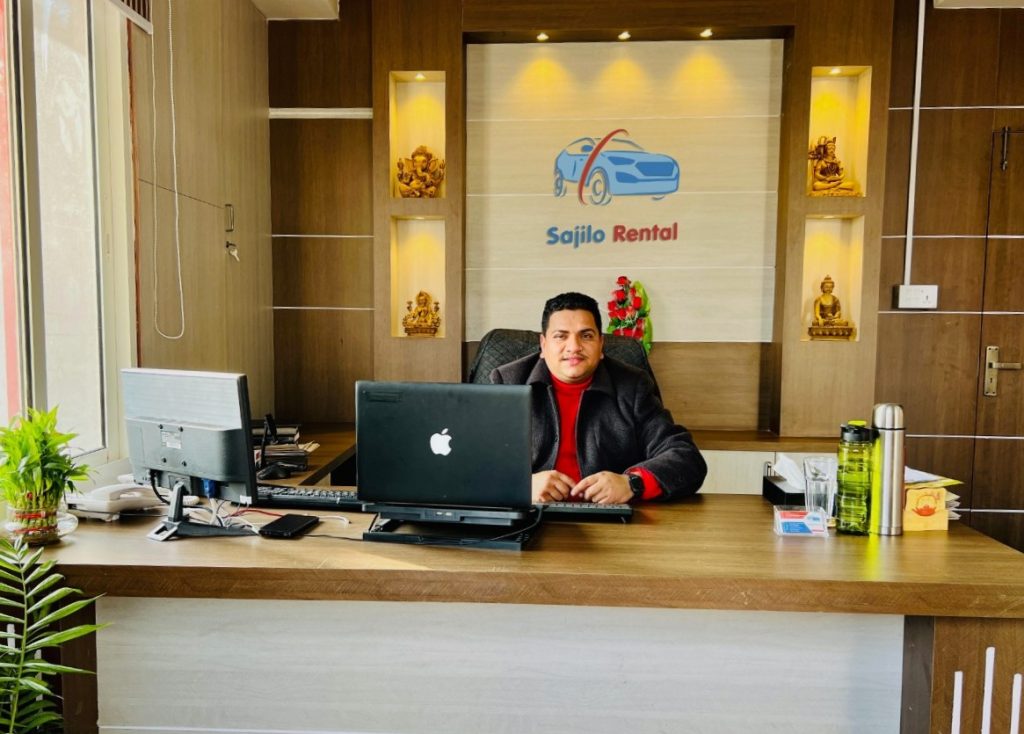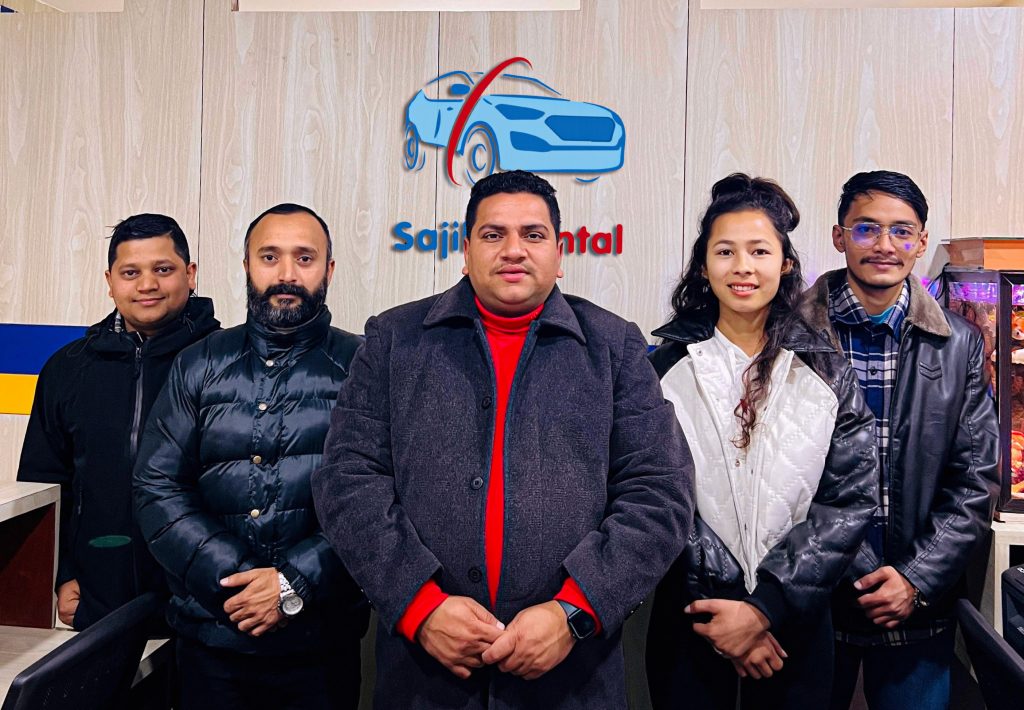
Suman Lamsal (33) needed a vehicle for a family trip. Bound to Dhor Barahi Temple of Tanahun, he needed to arrange a vehicle for 3 am on December 10, 2022. Getting a vehicle at 3 am in Kathmandu is really difficult. But, as he was searching, he remembered that he had read about Sajilo Rental somewhere, so he reached out to the platform and booked the vehicle.
“I was very sceptical at first as I was booking the vehicle online for the first time and I did not know what kind of service I would be getting. But to my surprise, the vehicle arrived on time and it was well-maintained too. The driver was experienced and polite throughout the journey,” he says, “We had to pick up some members from Muglin, and though there was some delay, the driver was calm and waited without any complaints. It made us all comfortable too.”
With 14 members on the trip, Raniban-resident Lamsal shares that the trip was unstressful and they reached home by 11 pm that very day.
Kathmandu residents are well aware of many ride-sharing apps running and thriving within the city. But, Sajilo Rental is not a ride-sharing app, claim its founders.
“We are a vehicle-renting app. So those who want to rent a vehicle or rent out their vehicles, for short or long-distance travel, can use our platform,” says CEO Damodar Phuyal (Prajwol).
Standing out in the market
Phuyal hence says Sajilo Rental is not competing with ride-sharing apps in Kathmandu.
“Our target is to cater to the people who want to rent a vehicle for long-distance travel or an emergency.”

Sajilo Rental is the brainchild of Arjun Prasad Phuyal. The concept is similar to Uber Rentals in the US and Zoomcar in India. “Inspired by other services outside, my brother Arjun thought of bringing the concept here in Nepal too,” Phuyal says, “Although the concept was three years in the making, we launched our mobile app and website in January 2021, without a vehicle that we owned, but the customers.”
While Arjun supports the business technically from the US, his brother Damodar manages the operation here in Nepal.
When the team first introduced the concept to the car owners here, Damodar Phuyal says, people were taken aback. “People questioned if Nepal had reached a stage where people go to an app and book the vehicles. And, it took a bit of convincing on our part. But the benefits outweighed their initial doubts.”
And, in a year, they have collaborated with over 100 car owners, other travel agencies, and car rental services listing over 1,500 vehicles of different varieties for customers to choose from.
Among them is Sanjib Shrestha (27), a hotelier at Lazimpat who took the initiative and rented out two of his Scorpios.
“I found out about the app from a social media platform. I approached them and liked their business approach. So I registered with them and it has been some four months now and we have already done some 25 to 30 trips, both in and out of Kathmandu,” says Shrestha.
Shrestha says he used to rent out his vehicles in the past too, but Sajilo Rental’s timely payment and the reasonable range of the fees too kept him going with the platform.
The new company has expanded to almost all major hubs of Nepal including but not limited to Kathmandu, Pokhara, Chitwan, Butwal, Dhangadhi, Nepalgunj, Itahari and Birtamode. It has a station in each hub, from where the users can coordinate the car rental services.
“The prices are transparent and fixed on a per-day basis (exclusive of tax and expense for the driver). It creates open competition among vehicle owners too,” Phuyal says, “Given any changes in the trip or the package, the owners and the customers can fix it too. And, we send experienced drivers associated with us along with the vehicles.”
How does Sajilo Rental work?

To book a vehicle, one has to log into the platform. One can book any of the available vehicles for city rides, for a minimum of four to eight hours or from one month and above for regular use or as per their needs. Customers need to pay an advance to confirm their booking using any of the popular payment gateway systems.
If anyone has a problem booking through the app, they can even contact the startup via their social media or reach out to 24/7 customer support. And, they will get a car with a driver to take them around. Self-driving option is not yet available on the platform.
Vehicle owners have to fill out a six-page form to list their cars on the platform. On the customer side, when they book the vehicles, they are given a list of guidelines to follow while they use the vehicles and the compensation they need to pay if they fail to do so.
Once the transaction is done, after the vehicle is used, customers will pay the quoted amount to Sajilo Rental, which will deduct its 10 per cent commission and pay the rest to the owners. If the customers want a VAT bill, the option is also available.
The driving force
Just a year old in the market, Sajilo Rental claims it bridged some of the key problems of the market including transparent rates, timely payments, and around-the-clock services.
“One of the major demands we noticed after we started was that people need vehicles in emergencies, either for health or family emergencies. So, the startup updated itself and now we are available 24/7 to give people the service and bridge the gap,” explains Phuyal.
Project Manager Janardhan Gautam adds, “Say, for any event or family tours when customers contact the rental services, they [like Lamsal] are uncertain what car they will get and what kind of driver they will get and whether they will be as per their need. And, the service [from other companies] also comes in with big underlying commission rates that people are unaware of.”
“We addressed all that and have kept our rates very transparent. Also, people can choose the vehicles they want from our platform.”
The startup has a policy to clear the dues within a week of the booking, so the car owners are very happy with their services. Apart from that, updating as per the customers’ needs has been the USP of the company. “Now we have also introduced carpooling to our customers.”

Next stop: Carpooling
Carpooling is something that people have attempted to introduce in Kathmandu a few times. Given that the city is one of the most populated in terms of people and vehicles, an average traveller spends a significant amount of time in a traffic jam. And like many cities, carpooling is a theoretically viable concept to try in Kathmandu too. However, it has failed, except for a few personal attempts.
Sajilo Rental is again bringing the concept exclusively to its customers. “Vehicle owners can bid a price and customers can talk directly to the owners to get the service. We do not interfere with the process or take a commission on the transaction,” Phuyal says, “We are just giving them the platform for now.”
He claims carpooling is an economical way to travel; it is very beneficial for travel agencies and frequent on-road travellers. “Instead of travelling empty, one way or both ways, people can opt for the option and at least cover their fuel expenses,” he says, “In the long term, it can lower the economical burden on the national economy and be more environment-friendly.”
“We already depend on imported fossil fuels heavily so we can reduce some fuel consumption and even reduce traffic on the road,” he adds.
Carpooling through Sajilo Rental is also not yet a feasible option for Kathmandu riders, says Phuyal. “We have city riders who book family trips to a few landmarks around the city, but carpooling in Kathmandu needs more research and a more complex system. And above all, we have to first familiarise the concept to people. So it will be a while.”
Another thing the team is working on is the travelling insurance for the travellers. “Currently, we can provide group accident insurance per car that is valid for a year. But, travel insurance in Nepal has many complications,” he says, “So even if we want to provide one-day or one-week insurance to the customers, it has not been feasible for us. But, we are in talks with many insurance companies.”
Also, like Uber Rentals or Zoom Car, Sajilo Rental is working on providing a self-driving option too. “That too will take time and will work if and only the owners agree. To organise the system though, we will need better insurance options and better policies. Regardless, creating that trust among people might be the most difficult task. “





















